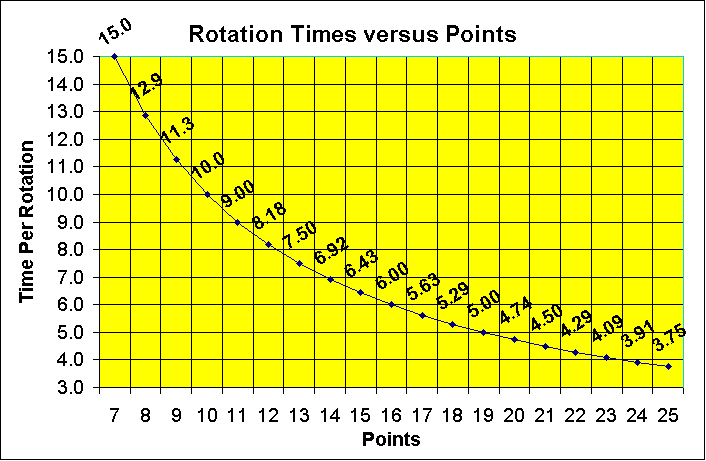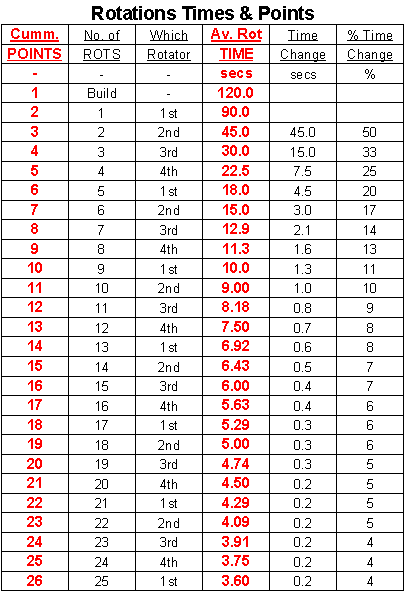General Description
This is a points based event with a time limit.
There are two "clocks" or time limits imposed.
A team of four parachutists exit an aircraft with a
cameraperson. The first clock starts when the first person (excluding the
cameraperson) leaves the aircraft. The team builds a quad formation ( 4 stack /
plane). The second clock starts either when the quad is built or after 30
seconds, whichever comes first.
The team then has 90 seconds to perform as many
rotations as possible. A rotation is when the top person (pilot) leaves the 4
way formation and flies to and rejoins onto the bottom of the formation to
rebuild another 4 way formation. One point is derived from the initial build and
then each rotation earns a further point. If the team does not build a formation
within a total of 120 seconds (30 + 90) from exit, they score zero points. The
team with the most points at the end of the competition (usually 8 rounds with
one throwaway) is declared the winner.
There is no draw for this event as there is only one
formation (4 stack/plane) which is repeated throughout the jump.
Click here for
4 Way Rotations tips and techniques.
Competition Rules - Australia
 The riser has been included in the
plane/stack grip. It is expected that the APF will adopt this rule at its next
board meeting in May, 2005. Therefore: The riser has been included in the
plane/stack grip. It is expected that the APF will adopt this rule at its next
board meeting in May, 2005. Therefore:
The FAI competition rules has been
adopted for Australian competitions. See FAI rules below.
Click here for complete
rules & regulations.
Dive Pool

Joke! Get it?
Competition Rules - International (FAI)
Click here for complete
rules & regulations.
Fédération
Aéronautique Internationale
INTERNATIONAL PARACHUTE COMMISSION
World Cup In Canopy Formation - Competition Rules
- Effective 01 May 2005
2. DEFINITIONS
2.1 Formation: Consists of 3 or more (2 for the 2-way event) jumpers
and canopies linked by grips, correct or not.
2.2 Grip: Consists of a hold on the "A" lines or front
risers so that a formation is built in accordance with the diagrams.
2.3 Configurations
2.3.1 Stack: The shoulder of the upper jumper must be above the
upper surface of the lower canopy. The grip must be on a line attached to the
centre cell.
2.3.3 Plane: The head of the upper jumper must be below the lower
surface of the lower canopy. The grip must be on the front risers or a line
attached to the centre cell.
2.3.4 Plane/stack: Plane/stack or any position on a riser or a line
attached to the centre cell between these configurations. A correct grip must
be maintained.
The above configurations only apply to complete formations.
3. THE EVENTS
3.2 Performance requirement:
3.2.2 4-way rotation event: Each round consists of successive 4-way
plane/stack formations made by rotations. Rotations must be made by the top
competitor in the complete formation dropping grips, flying to the bottom of the
formation and again completing a 4-way plane/stack formation. The intermediate
formation is the remaining correctly completed 3-way plane/stack formation.
5. RULES SPECIFIC TO THE EVENTS
5.2 4-Way Rotation Event:
5.2.1 Exit altitude shall be 2150 metres (~7,000 ft) AGL with a working time of
90 seconds.
5.2.2 The Working Time and Scoring begins with the first 4-way plane/stack
formation whether correct or not, or 30 seconds after exit of the first team
member, excluding the team's videographer, whichever is first. One point is
scored for every correctly completed 4-way plane/stack formation within the
working time, according to the performance requirement.
6. JUDGING RULES
6.3 Determination of Winners
4-WAY EVENTS:
-
Have the highest number of formations in the completed
rounds.
-
If 2 or more teams have an equal number of formations, the
first 3 places will be decided by the highest number of points in any
completed round for each team.
-
If there is still a tie, the team with the fastest time in
those rounds with the highest points wins the tied place.
-
Tied teams placed lower than third remain tied
Time and Points Data
The following graph and table show what times are required
to achieve a certain number of points on a CRW rotations jump. For comparison,
the winning average score at The World Championship is typically around 20. In
Australia, the winning average score has typically been around 14 points. The
world record is 22 and the Australian record is 17.


Some explanations of the data above:
- it is assumed that the first quad is built in 30 seconds or less & that working time is 90 seconds as per 2005 rules.
- the numbers on the curve are the average time per rotation to achieve the
points indicated on the horizontal axis. i.e. to achieve 18 points you need
to average less than 5.29 seconds per rotation.
- the spreadsheet columns are defined as follows:
- Cumm. Points = final judged score (assuming no busts).
- No. of Rots = The first point is achieved by building the initial
quad, each point thereafter is gained for each successful rotation.
Hence the second cummulative point is actually the first rotation.
- Which Rotator = tells you which person actually does the rotation for
each particular point. i.e. the 4th person completes the 17th point.
- Av. Rot Time = to achieve the cumulative score of 18 points, you need
to average less than 5.29 seconds. Note that you have a total 120
seconds to build the first quad (30sec build + 90sec working times). If
not, you will get zero points.
- Time Change = how much you have to improve by on average per rotation
to get the next score.
- % time change = what % you have to decrease your average by in order
to achieve the next score.

| 